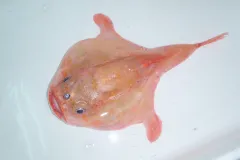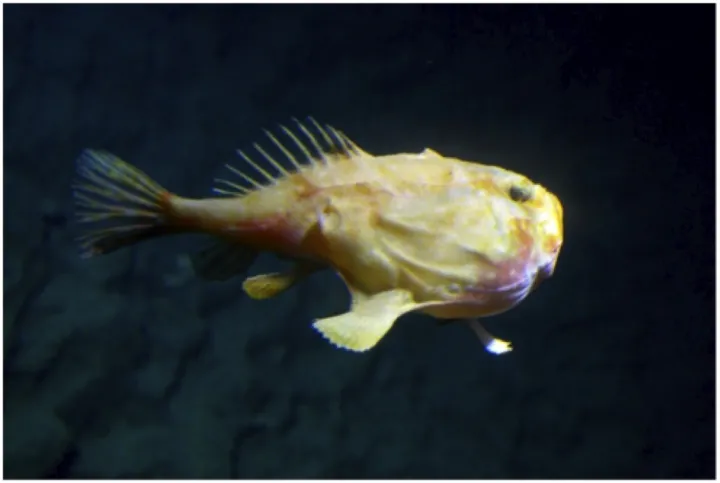A Sub and a Sea Toad

Have you ever seen a creature so unusual? This fish (22 cm long) is called a sea toad and studying them requires luck and the opportunity to descend into the deep waters where they live.
Last week Dr. Carole Baldwin and other ichthyologists participating in the Smithsonian Institution’s Deep Reef Observation Project (DROP) were exploring waters off the coast of Curaçao in a submersible. While on a slope at a depth of 215 meters (about 700 ft) the fish team and the Curasub crew came across a sea toad walking along the bottom.
The team was excited because this fish did not look like either of the sea toad species they had collected in deep waters off Central America earlier this year. One of which, Chaunax pictus (shown right), was caught at a deeper depth of 396 meters (about 1,300 ft). By comparing the genetic data from the Curaçao sea toad with that of the other two Caribbean specimens caught off the coast of Honduras, the team hopes to learn more about the genetic diversity and patterns of distribution for this group.
If the fish turns out to be the same species, it would be the first time scientists could compare genetic differences between individuals caught in Curaçao and other parts of the Caribbean. It is also possible that the Curaçao sea toad represents a new, previously unknown and unnamed species.
These strange-looking fishes (shown above and left) belong to a group of anglerfishes known as lophiiforms. They are related to the “scary,” jagged-toothed deep-sea anglerfish many recognize from the movie Finding Nemo. These, along with other anglerfishes, have a movable, modified dorsal-fin spine projecting from the head that serves as a lure for capturing prey.
So the excitement was high when the team went to collect the fish. But, when working in this environment, one needs to be prepared for the unexpected, and ready to do some quick and creative problem-solving. When the team went to collect this fish with the sub’s suction tube, the fish filled itself up with water, making it too large to fit through the tube!
The team decided to use the suction tube and robotic arm to deposit the fish in an open-collection bucket at the front of the submersible, which is normally used to hold slow-moving organisms like sea urchins and sea stars. Later in the expedition when the sub made a quick descent, the sea toad floated out and swam away, but not before the team snapped this unique photo (above, left)! As these fishes are bottom-dwellers, you wouldn’t normally see them swimming in the water column like this.
Although the team was not able collect this individual, they have collected specimens of other species with the Curasub, some of which Carole Baldwin believes could be new species. Observing and collecting deep-sea marine life with a 5.5 ton piece of machinery isn’t easy, but it’s a challenge the scientists and the sub team are ready for! Check back next week to see what the team finds.
Editor's Note: This is the second post in the "Summer in a Sub" blog series, which features the work of the Smithsonian's Deep Reef Observation Project (DROP).


